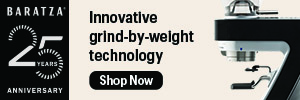Joe has been my friend since 1975, when I started working for his father’s company. At the time, Joe was still in university and came in on weekends and summers to work as the “print boy” in the engineering office where I was employed. After he completed his undergraduate and graduate degrees, he came to work for the company full time and within a few years was my immediate supervisor; I moved up from engineering to matters commercial, and this was Joe’s speciality. He eventually became the owner of the company.
We worked in the steel industry, which meant an environment that was hot (steel melts at around 1370C / 2500F), dirty, loud, and dangerous…a real man’s industry. We travelled the world, often together, and we both came to have an appreciation for espresso. Over the years, I was able to convince him to buy several espresso machines for the office. Perhaps “convince” is not the correct word to use, since he was pretty set on having proper coffee at the office anyway. The company bought a couple of Coffee Gaggia and even a Cimbali Jr. with a Cimbali Jr. grinder. Ahhh…business was good!
The company was sold some years back and Joe now lives in Tampa, Florida, while I remain in Pittsburgh. In a recent telephone conversation, he mentioned that there were few (actually, he said “no”) good espresso places in Tampa. Sacré bleu! How is this possible? Tampa is a pretty sizable metropolitan area and certainly “upscale.”
This sparked a posting I made in the CoffeeGeek forums, enquiring as to the coffee scene in Tampa. The responses indicated that it was indeed a pretty dismal place for espresso other than in one’s home. I sent the link to Joe so he could read the responses for himself, and he called back to ask if I would make some recommendations for a “decent set-up” for him to use at home. Sure. Who doesn’t like spending other people’s money?
The Man
Joe is not a coffee-making kind of guy and never has been. He always had me or his older brother Nik around to make the espresso for him, and more often, he was content to run to the coffee bar as needed. Even after the company was sold and he, like me, was “just” an employee, we would often leave the office in the middle of the morning or afternoon to run down to Pittsburgh’s La Prima espresso bar – about 20 miles distant – to get a quick fix.
Joe has continued his “outside sourcing” of espresso, and I am certain that, in addition to the coffee, the social aspect of going to a coffee bar appeals to him, as it does to me. Still, he should be capable of developing the skills to make a proper shot. Perhaps it is just that as he passes the mid-century mark, he realizes that he, too, needs to be “his own man” and learn how to make espresso.
Joe is a (sort of) “well off” guy, so I wasn’t too concerned with the costs of that which I recommended. Certainly there are better and much more costly choices, such as La Cimbali, La Marzocco or Synesso. But knowing him as I do, he would feel that spending $5,000 on an espresso machine – something he would use several times a day, every day of his life – was too outlandish; as opposed to spending $5,000 on a watch or some such trinket that will most likely be left in a drawer and pulled out only on rare occasions. So, in putting together my recommendations, I decided to offer him three setups, each at a different price point, so that even if he chose to skimp, he would still be able to make himself good quality espresso drinks.
Primer on Machines
ince Joe is a novice, I defined some terminology and provided some basic information about the machinery and their component parts, so he could better understand the recommendations.
Heat exchanger
A heat exchanger (HX) machine allows you to steam milk whilst pulling the shot, but more importantly, it has a much more stable temperature profile than a single boiler (or a thermoblock) machine, such as his brother Nik’s Francis!Francis! or the Gaggias we formerly had in the office. In an HX machine, the brew water is routed through a heat exchanger which passes through the boiler, thereby flash heating the brew water. It was one of the significant developments by Faema in 1961 and allowed the use of a pump for espresso (all machines had previously been piston types like the Pavoni Europiccola), since it solved the problem of hot water passing through the pump. All of the machines I recommended to Joe are HX machines.
Rotary pump
The rotary pump is the best of the best and is what practically every coffee bar uses. The “downside” of a rotary is that you must assure a water flow or the pump will be damaged. Therefore, if you go with a machine having a rotary pump, you will need to plumb it in to your water supply which will add a little to the cost (for filtration and possibly water softening) but also to the convenience (as you will never have to fill the machine).
Vibratory pump
The vibratory pump is the standard kind of pump one finds on a home espresso machine and is what we had on all the company espresso machines. They are most certainly serviceable; my home machine has this type of pump.
Portafilter
The portafilter (PF) is the handled device that holds the basket into which the ground coffee is placed. The PF is then inserted into the underside of the grouphead and turned (usually counterclockwise) about 60 degrees to lock it into place. The espresso comes out of the PF and falls into the cup(s).
Grouphead
The grouphead is the apparatus from which the water is dispensed into the PF and through the ground coffee.
Faema E61 grouphead
The E61 design is a classic and is one of the most desired groupheads for home baristas. OK, they call it a brew group… but you get the idea. My machine uses an E61, but it doesn’t have the classic lever-actuated E61, since my machine is an automatic (meaning that the water dispensing is automatically controlled). The E61 provides a most stable espresso extraction due to its mass and, more importantly, its thermal-siphon. The thermal-siphon means that heated water is circulated through the grouphead to keep it at an elevated temperature which also means that you must pull a significant cooling flush before each shot. It also employs pre-infusion (where the coffee puck is “infused” with hot water before the pump pressure is fully applied), which improves the espresso.
Pressure stat
The pressure stat (PS) is the mechanism that keeps the boiler up to its set pressure (as opposed to a set temperature) by controlling the on-off cycle of the heating element. Most home machines use one of two pressure stats: either the MA-TER or the CEME. Both of these are small and lightweight, able to fit into a 2″ cube. The upscale pressure stat used in virtually every professional machine is the Sirai, which has a higher amperage rating in addition to being much larger physically (about 2″ x 3″ x 4″).
Boiler size
The volume of the boiler (usually given in liters) speaks of the “strength” of the machine. Most commercial machines have boilers of several liters (say 6 to 12) while most “better” home machines will always have a boiler of greater than 1 liter. Basically speaking, two things happen as boiler size increases: the machine takes longer to heat up (from cold start) and the machine will go longer without running out steam pressure. Another way of saying the latter is that the machine will have a more stable temperature profile throughout the shot since the inertia of temperature will be more evident with more mass/volume.
Size and space
You should check that your available counter space and overhead cabinet clearance (the distance form the bottom of the overhead cabinets to the top of the kitchen counter) will allow the use of whatever machines you choose.
Dishing Out Advice
I urged Joe not to run out and buy something just because his brother Nik or someone else tells him that it is OK. While he may get “serviceable” equipment, he will (most likely) not get the best for the buck.
So, what will the coffees look like? Even with the “low end” setup, assuming that you have freshly roasted coffee beans, properly ground, distributed and tamped and that the machine is set up correctly.
As I told Joe, all of the espresso and the cappuccino were made with the “Low End” equipment. He was admonished to look at them and drool.
The taste? Imagine…
I have yet to hear back from Joe.




















































